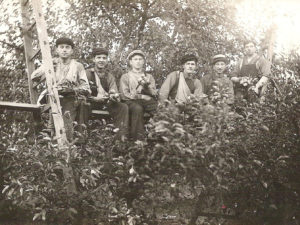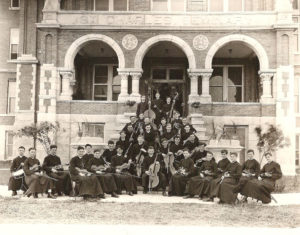St. Charles Center History
History of St. Charles pre-1960
The Missionaries were first assigned to Peru, Ohio. From there, Fr. Brunner commenced to serve the many German-speaking parishes in central and western Ohio, including in Mercer County, where he came in 1845. Along the way, he established a series of mission houses in these parishes to assist the Missionaries in their work. He also founded the Sorrowful Mother Shrine near Bellevue, Ohio, in 1850, and a seminary in Thompson, Ohio.
The Missionaries had outgrown that seminary by the time Fr. Brunner died on December 29, 1859. The task of relocating to a larger seminary fell to Fr. Andrew Kunkler, C.PP.S. Fr. Kunkler was given a dual directive by the moderator general in Rome, Fr. Giovanni Merlini, C.PP.S. (now Venerable Giovani Merlini), the moderator general, to found a house to serve both as a seminary and a motherhouse.
The Missionaries found a suitable 200-acre parcel of land for sale in Mercer County. The property was that of the former Emlen Institute and its farm, near the African-American settlement of Carthagena, Ohio. Augustus Wattles, a Quaker abolitionist and educator, had established a training school for African-American youths. Wattles directed the school until 1857 when he left the school due to racial bigotry shown by local Yankee Democrats. The school’s trustees moved the school to Pennsylvania in 1859 and sold the property. Through the efforts of Fr. Joseph Dwenger, C.PP.S. (later bishop of Fort Wayne), the Missionaries purchased the property in 1861 and converted it to a seminary named after St. Charles Borromeo, the patron saint of seminarians. There were 15 seminarians when St. Charles opened its doors in June 1861 with Fr. Dwenger as its first rector.
The Missionaries built a new brick seminary in 1878 to accommodate an increase in seminarians. As the first building of a long-range plan, the self-standing Chapel of the Assumption of Mary was completed next. In 1919, the Missionaries broke ground for a much larger seminary building that was to face the highway (U.S. Route 127). Archbishop Henry Moeller of Cincinnati officiated at its dedication on August 22, 1922. Thousands of people attended.
St. Charles Seminary was built to house up to 120 seminarians, but by 1950 was proving to be outdated. The Missionaries took on another extensive project, renovating the main building and adding two wings. The first contained a larger kitchen, larger dining rooms (one of which is now the St. Gaspar Room), an auditorium, and a new convent to house the Sisters of the Precious Blood who ministered there. The second was the infirmary, which provided a place to care for sick and infirm members. Archbishop Karl J. Alter blessed the new facilities on April 29, 1958.
Also in that era, the chapel was renovated in time for St. Charles’ centenary celebration in 1961, and the Missionaries’ printing operation, the Messenger Press, was relocated from the St. Charles main building to a new building west of the seminary. (Messenger Press is now a privately-owned printing firm.)
In those days, St. Charles was a near self-contained and self-supporting institution. Besides the many priests who taught the seminarians, numerous brothers worked the land or in the barns, with the assistance of seminarians. St. Charles’ grounds included a dairy, the orchard and gardens, and lakes for fishing and swimming. The seminary had its own powerhouse, post office and firetruck. In the auditorium, the seminarians provided entertainment in the way of plays and musicals.
To learn more about St. Charles Center today, click here.





